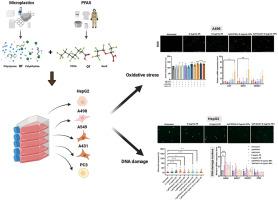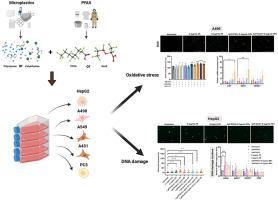Synergistic toxicity of PFAS and microplastic mixtures across five human cell lines
IF 7.3
2区 环境科学与生态学
Q1 ENVIRONMENTAL SCIENCES
引用次数: 0
Abstract
Per- and polyfluoroalkyl substances and microplastics (MPs) are ubiquitous environmental contaminants that frequently co-occur in aquatic ecosystems and human exposure pathways. While their individual toxicities have been extensively studied, the combined effects of PFAS and MP co-exposure on human health remain poorly understood. This study evaluated cytotoxic, oxidative, and genotoxic responses in five human-derived cell lines—A498 (kidney), HepG2 (liver), PC3 (prostate), A431 (skin), and A549 (lung)—following exposure to environmentally relevant concentrations of perfluorooctanoic acid (PFOA), hexafluoropropylene oxide-dimer acid (GenX), polystyrene, and low-density polyethylene, both individually and in mixtures. Our findings showed potential synergistic effects were observed primarily in kidney and liver cell lines, including increased reactive oxygen species production, elevated antioxidant gene expression, and activation of DNA repair pathways. Mixture toxicity was dependent on both dose and PFAS-to-MP ratio, with synergistic responses predominating. A498 cells consistently showed greater sensitivity than HepG2 across all toxicity endpoints, including increased ROS, antioxidant gene expression, and activation of DNA repair pathways. HepG2 cells exhibited more limited oxidative stress responses but showed significant DNA damage and H2AX upregulation in select treatments. Gene expression data suggest differential activation of redox and DNA damage response pathways between the two cell types. These findings highlight the need to incorporate mixture toxicity into risk assessments and identify oxidative stress and genotoxicity as central mechanisms of concern in PFAS and MP co-exposure.


PFAS和微塑料混合物在五种人类细胞系中的协同毒性
Perand多氟烷基物质(PFAS)和微塑料(MPs)是普遍存在的环境污染物,经常在水生生态系统和人类接触途径中共同出现。虽然对它们各自的毒性进行了广泛的研究,但对PFAS和MP共同暴露对人体健康的综合影响仍知之甚少。本研究评估了五种人类来源的细胞系——a498(肾)、HepG2(肝)、PC3(前列腺)、A431(皮肤)和A549(肺)——暴露于环境相关浓度的全氟辛酸(PFOA)、六氟环氧丙烷二聚酸(GenX)、聚苯乙烯和低密度聚乙烯(单独或混合)后的细胞毒性、氧化性和基因毒性反应。我们的研究结果表明,潜在的协同作用主要在肾脏和肝脏细胞系中观察到,包括增加活性氧的产生,提高抗氧化基因表达和激活DNA修复途径。混合毒性依赖于剂量和pfas - mp比例,以协同反应为主。A498细胞在所有毒性终点均表现出比HepG2更高的敏感性,包括ROS增加、抗氧化基因表达和DNA修复途径的激活。HepG2细胞表现出更有限的氧化应激反应,但在某些处理中表现出明显的DNA损伤和H2AX上调。基因表达数据表明,两种细胞类型之间氧化还原和DNA损伤反应途径的激活存在差异。这些发现强调了将混合毒性纳入风险评估的必要性,并确定氧化应激和遗传毒性是PFAS和MP共暴露的主要关注机制。
本文章由计算机程序翻译,如有差异,请以英文原文为准。
求助全文
约1分钟内获得全文
求助全文
来源期刊

Environmental Pollution
环境科学-环境科学
CiteScore
16.00
自引率
6.70%
发文量
2082
审稿时长
2.9 months
期刊介绍:
Environmental Pollution is an international peer-reviewed journal that publishes high-quality research papers and review articles covering all aspects of environmental pollution and its impacts on ecosystems and human health.
Subject areas include, but are not limited to:
• Sources and occurrences of pollutants that are clearly defined and measured in environmental compartments, food and food-related items, and human bodies;
• Interlinks between contaminant exposure and biological, ecological, and human health effects, including those of climate change;
• Contaminants of emerging concerns (including but not limited to antibiotic resistant microorganisms or genes, microplastics/nanoplastics, electronic wastes, light, and noise) and/or their biological, ecological, or human health effects;
• Laboratory and field studies on the remediation/mitigation of environmental pollution via new techniques and with clear links to biological, ecological, or human health effects;
• Modeling of pollution processes, patterns, or trends that is of clear environmental and/or human health interest;
• New techniques that measure and examine environmental occurrences, transport, behavior, and effects of pollutants within the environment or the laboratory, provided that they can be clearly used to address problems within regional or global environmental compartments.
 求助内容:
求助内容: 应助结果提醒方式:
应助结果提醒方式:


